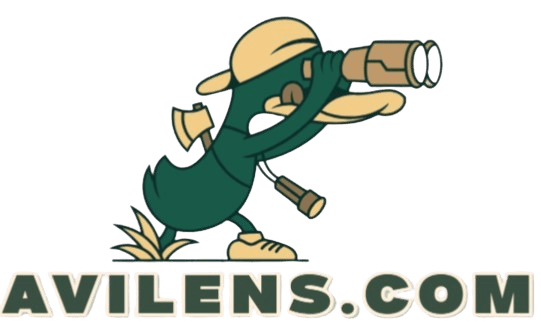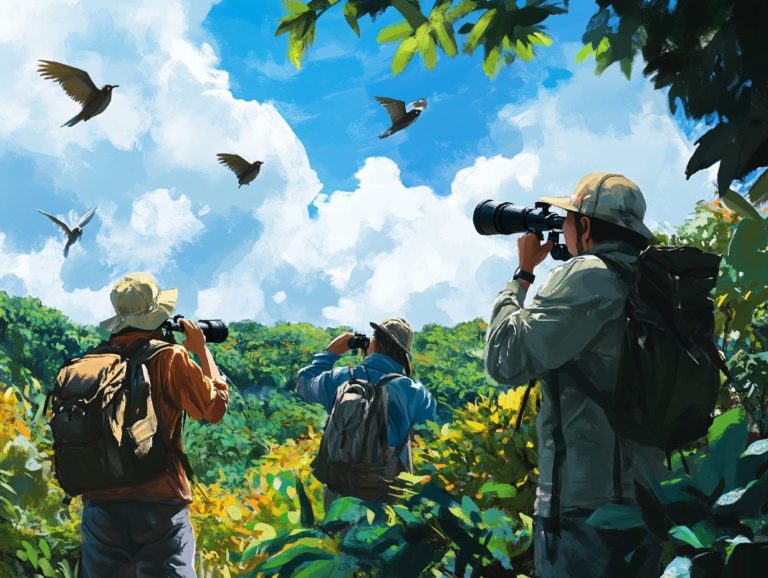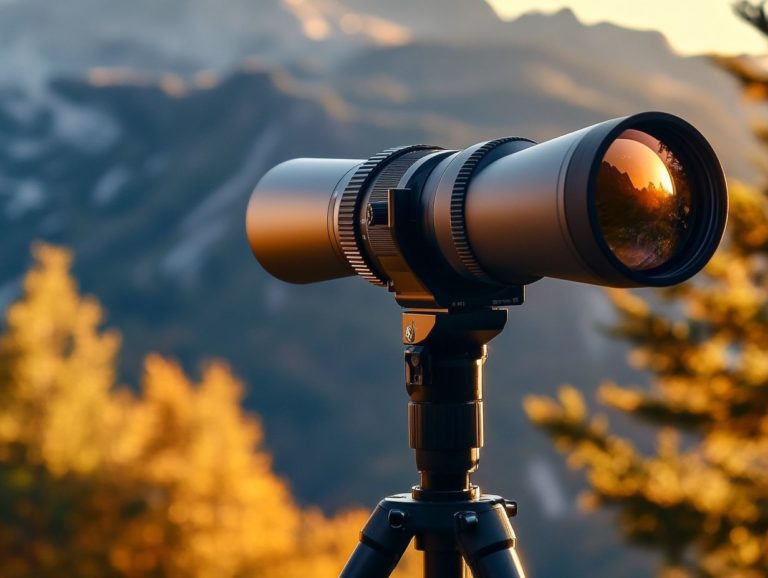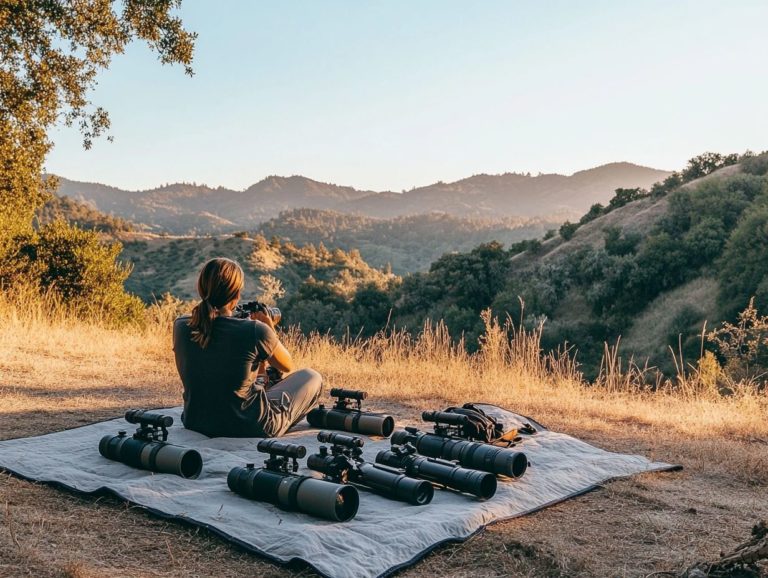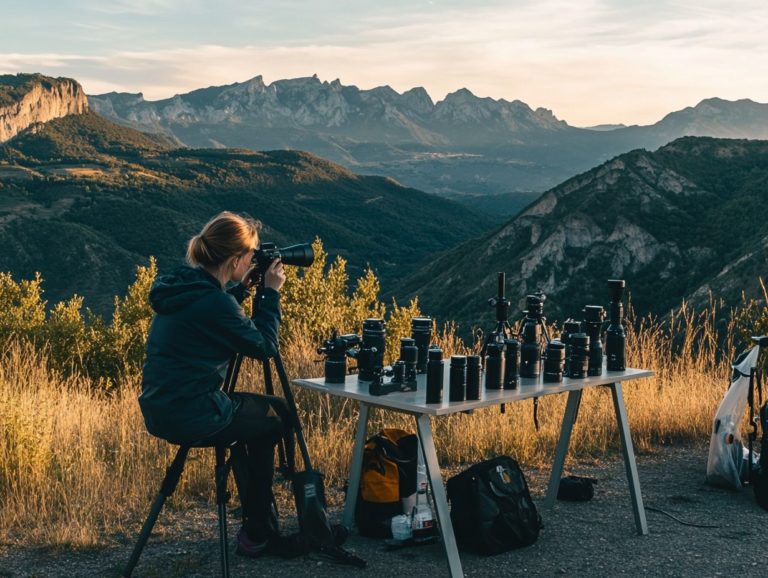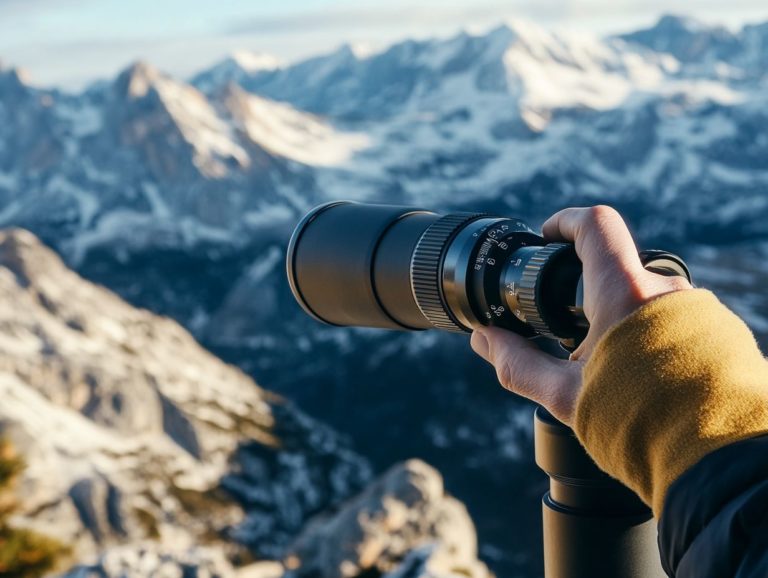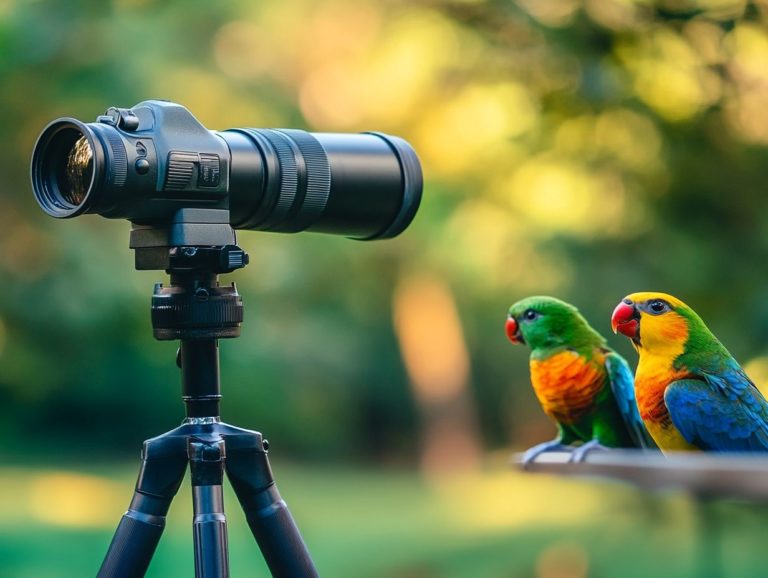Spotting Scope Etiquette: Best Practices in the Field
Spotting scopes open up a world of observation, allowing you to connect with nature in extraordinary ways. However, enjoying this experience comes with the responsibility of practicing proper etiquette.
This article explores essential best practices for setting up your spotting scope, offers tips for sharing it with others, and emphasizes the importance of respecting wildlife and the environment.
You ll find guidelines for group spotting and learn why maintaining your equipment is crucial.
Whether you’re experienced or new, these insights will enhance your love for the outdoors. They also ensure everyone enjoys a positive experience.
Contents
- Key Takeaways:
- Why Proper Etiquette is Important
- Setting Up Your Spotting Scope
- Sharing a Spotting Scope
- Respecting Wildlife and the Environment
- Essential Tips for Group Spotting
- Cleanliness and Maintenance
- Frequently Asked Questions about Spotting Scopes and Binoculars
- What is Spotting Scope Etiquette and Why is it Important in the Field for Birding and Wildlife Viewing?
- Should I Always Ask for Permission Before Using Someone Else’s Spotting Scope?
- What is the Proper Way to Handle a Spotting Scope?
- Are there rules for sharing a spotting scope?
- Is it okay to use a spotting scope in public?
- What safety precautions should I take in the field?
Key Takeaways:
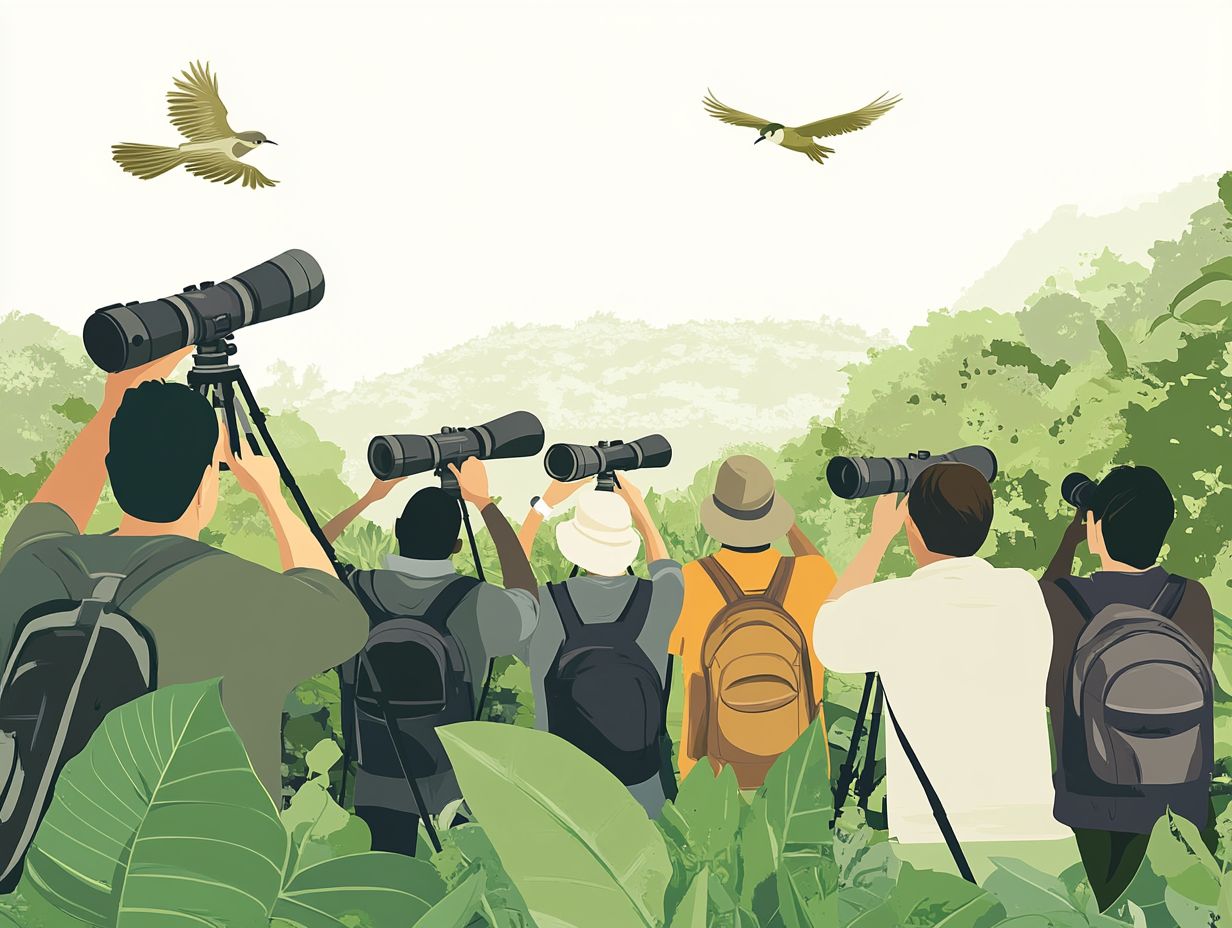
- Communicate with others to ensure everyone gets a chance to view wildlife.
- Respect nature by keeping your distance and minimizing disturbances.
- Keep your spotting scope clean and well-maintained for future use.
Why Proper Etiquette is Important
Using good manners during wildlife observation is crucial for elevating your experience and respecting the wildlife you encounter. This mindful approach allows nature lovers to fully appreciate the breathtaking beauty of the outdoors while ensuring that animals remain undisturbed.
Utilizing a quality spotting scope or binoculars in the Great Smoky Mountains not only offers exceptional clarity but also encourages responsible behavior among fellow enthusiasts who cherish the wonders of nature.
Setting Up Your Spotting Scope
Setting up your spotting scope properly is essential for maximizing performance and enhancing your wildlife viewing experiences, particularly in breathtaking locations like the Great Smoky Mountains, where superior optics truly elevate the moment.
Whether you choose an angled body or a straight body design, understanding key features such as the size of the lens that helps gather light for a clearer view and lens coatings can significantly enrich your outdoor adventures.
Best Practices for Setting Up
To ensure optimal performance with your spotting scope, follow best practices that will elevate your experience. Start by choosing a durable, fog-proof model equipped with high-quality optics tailored specifically for your wildlife viewing needs. Mastering the art of adjusting magnification and using the lens hood can dramatically enhance clarity and comfort during your observations.
Familiarize yourself with the array of adjustments your scope offers, such as focus settings and eye relief. Properly aligning the eyepiece for individual eye adjustment can significantly improve your viewing experience.
Don t overlook the importance of ergonomic design. A scope that facilitates ease of use during extended observation sessions especially in challenging weather makes all the difference.
Regular maintenance is key. Cleaning the lenses and inspecting for wear and tear will not only prolong the lifespan of your equipment but also ensure you capture every breathtaking moment in sharp detail.
Sharing a Spotting Scope
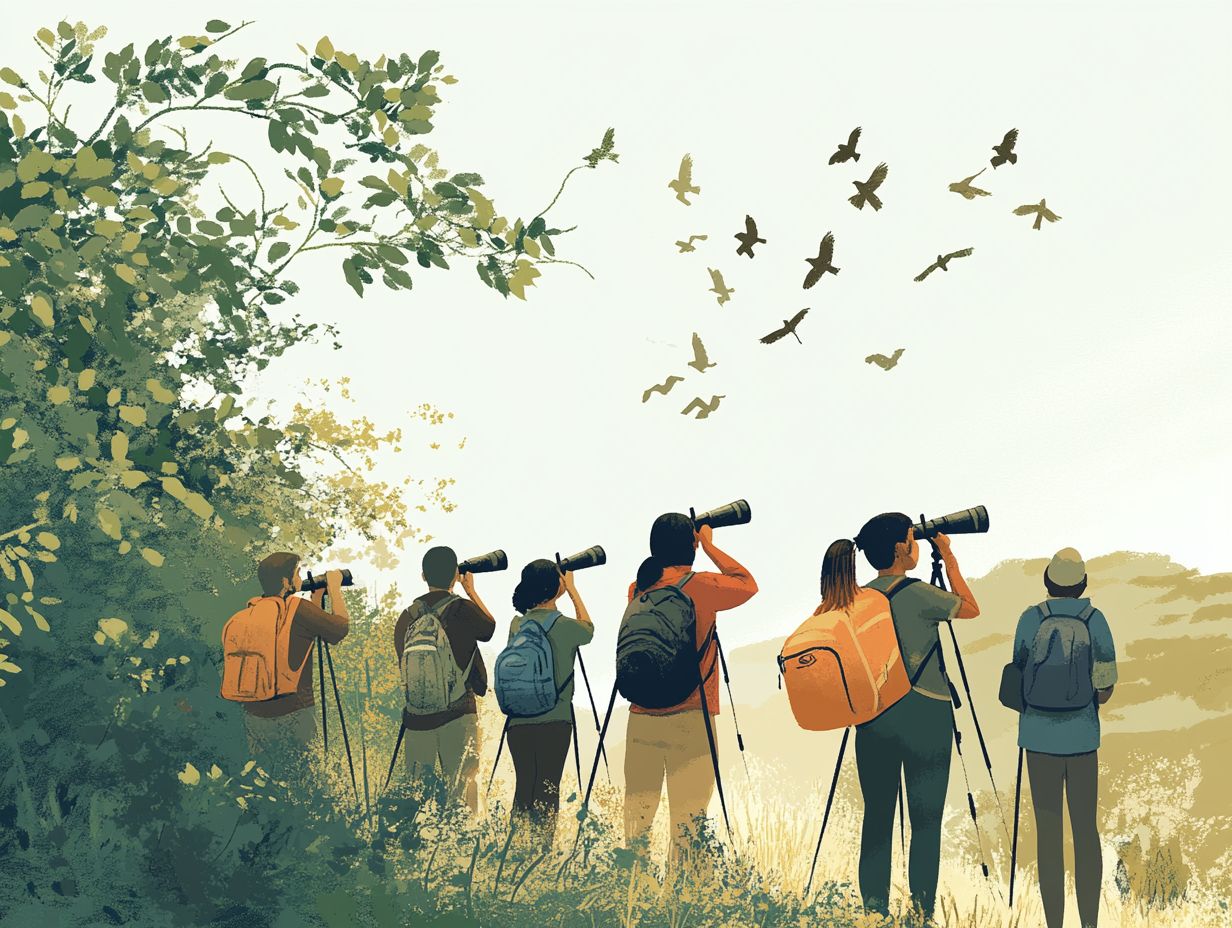
Sharing a spotting scope can transform your wildlife photography outings into a rewarding adventure, enabling you and your fellow enthusiasts to immerse yourselves in nature together.
By using a smartphone adapter for digiscoping, you elevate your viewing experience to new heights. Sharing this experience brings everyone together, making it unforgettable.
Ready to explore? Grab your spotting scope and head out to witness the wonders of nature!
Communicating and Collaborating with Others
Effective communication and collaboration among wildlife observers can significantly elevate your experience when spotting and identifying various species in their natural habitat. This shared journey fosters a sense of community among fellow nature enthusiasts engaged in outdoor pursuits.
By exchanging insights and techniques, you and your fellow observers can collectively sharpen your wildlife observation skills. This collaborative spirit deepens your understanding of natural environments and strengthens the bonds among those passionate about protecting wildlife.
Engaging in discussions about specific animal behaviors, habitat preferences, and seasonal migrations can unveil new perspectives and enhance your overall appreciation of nature. You might find yourself sharing valuable resources like field guides, apps for tracking species sightings, or information on local conservation efforts.
This exchange creates a well-informed group better equipped to appreciate the intricacies of wildlife. Such interactions promote a culture of learning, ensuring that each participant, whether novice or expert, feels enabled and connected to the shared mission of observing and preserving the natural world.
Respecting Wildlife and the Environment
Respecting wildlife and the environment is essential for anyone engaged in outdoor activities, such as birding and wildlife observation. This commitment not only preserves natural habitats but also safeguards the well-being of countless species.
By embracing responsible practices, you can play a crucial role in fostering a healthier ecosystem, especially in delicate regions like the Great Smoky Mountains. Your actions today will protect these habitats for future generations!
How to Respect Wildlife While Enjoying Nature
Minimizing disturbance and impact on wildlife is essential for preserving the delicate balance of natural environments. This is especially important during your outdoor adventures with quality optics like spotting scopes and binoculars, which are tools used for observing wildlife from a distance.
By adopting techniques such as maintaining a respectful distance and utilizing low light settings, you can immerse yourself in nature without disrupting the wildlife. Wearing camouflage clothing and limiting vocalizations creates a less intrusive environment.
It’s also wise to be mindful of the time of day when you venture into natural habitats. Early mornings or late afternoons usually offer quieter moments that are less disruptive. Your choice of equipment can further elevate the experience; high-quality optics not only provide clearer views but also reduce the need to get too close.
Ultimately, engaging in responsible wildlife observation deepens your appreciation for these creatures and helps sustain their natural behaviors, ensuring that future generations can also revel in the beauty of the wild.
Essential Tips for Group Spotting
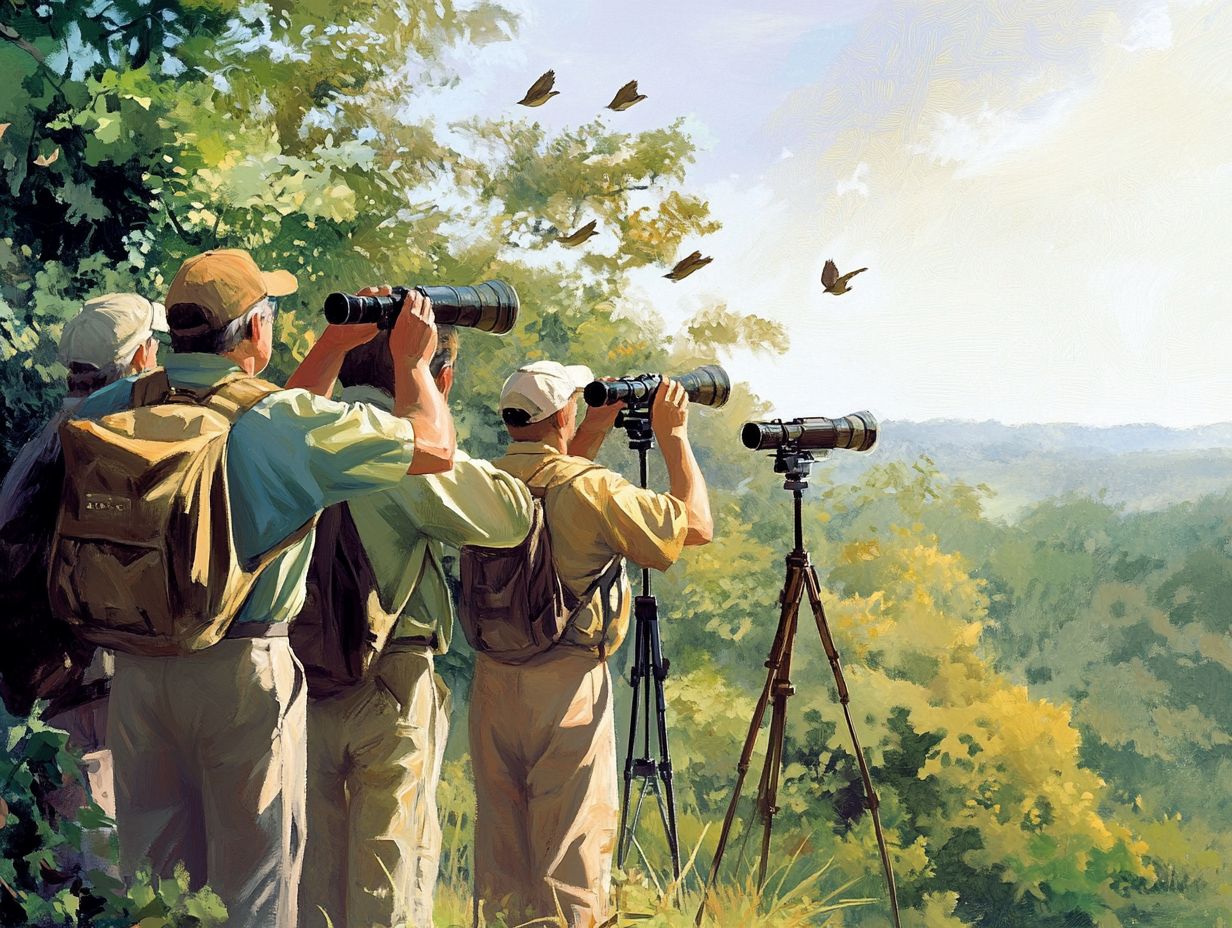
Mastering the etiquette of group spotting is vital for fostering a harmonious and enjoyable experience for everyone involved, especially when employing a spotting scope optics for wildlife photography.
By laying down clear communication protocols and encouraging collaboration among group members, you can ensure that all participants share in the thrill of wildlife observation. This approach not only enhances engagement but also deepens respect for the wonders of nature.
Join us in preserving our natural world!
Guidelines for Group Observation
Establishing guidelines for group observation can significantly improve the experience for everyone involved. This ensures seamless communication and a steadfast respect for wildlife throughout the activity. By setting clear expectations around sharing the spotting scope and promoting thoughtful dialogue about what you observe, you can foster a positive atmosphere that resonates with fellow wildlife enthusiasts.
This collaborative approach creates an engaging environment and makes each individual feel valued and included. It s important that you feel encouraged to voice your insights while remaining mindful of others, allowing for a richer exchange of perspectives.
Protocols for sharing equipment like spotting scopes are essential; this minimizes wait times and maximizes opportunities for all.
It s crucial to maintain a respectful atmosphere. Observing wildlife should not disrupt their natural habitats. By cultivating a shared sense of responsibility, you and your group can truly appreciate the beauty of nature together!
Cleanliness and Maintenance
Maintaining cleanliness and proper upkeep of your spotting scope is essential for ensuring long-term performance and an optimal viewing experience, especially if you re a nature enthusiast exploring the great outdoors.
Regularly inspecting the lens for dirt and verifying that the waterproof features are intact can greatly enhance your wildlife observation adventures.
Keeping Your Spotting Scope in Good Condition
To keep your spotting scope in excellent condition, it s essential to perform regular maintenance. This includes cleaning the high-quality optics and checking the lens coatings for any signs of wear. By following simple care routines, you can ensure that your equipment remains dependable for capturing breathtaking wildlife photographs and observations.
Implementing regular maintenance practices for your spotting scope can significantly enhance its longevity and performance. Begin by using a soft, lint-free cloth to clean the lenses, steering clear of paper products that could scratch the coatings. For stubborn spots, apply a few drops of lens cleaning solution to the cloth.
After cleaning, inspect the scope for any dust or debris lodged in the eyepiece or objective size lenses. It’s also crucial to check the seals and O-rings for any signs of deterioration, as these components protect against moisture and dust intrusion. By keeping a vigilant eye on both the optical elements and structural integrity, your spotting scope can provide optimal performance for years to come. If you’re into digiscoping, which involves using a digital camera attached to a spotting scope for photography, ensure your setup is compatible with your smartphone adapter.
Frequently Asked Questions about Spotting Scopes and Binoculars
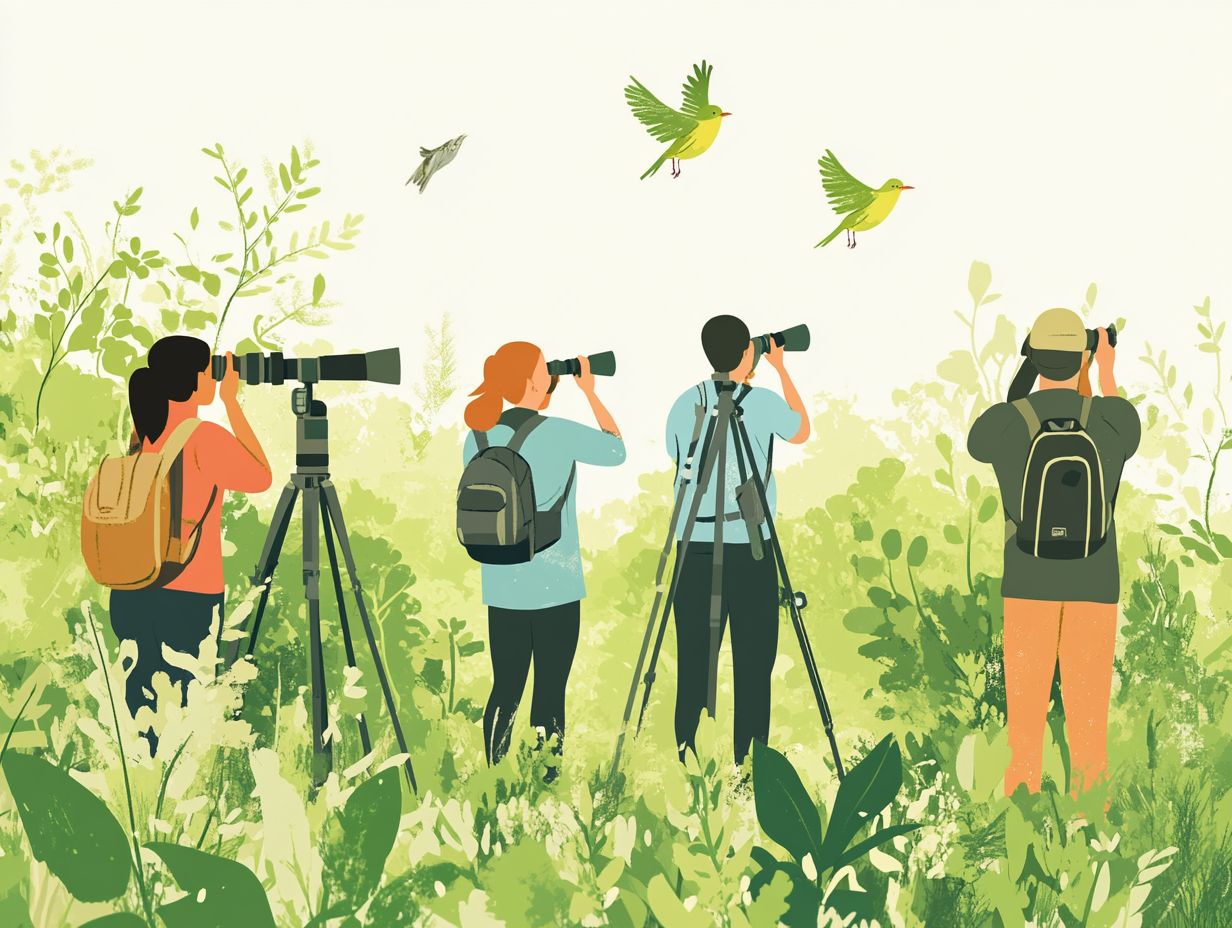
What is Spotting Scope Etiquette and Why is it Important in the Field for Birding and Wildlife Viewing?
Spotting Scope Etiquette refers to the proper manners and behavior when using a spotting scope in the field, whether it be for birdwatching, hunting, or other outdoor activities. Understanding this etiquette is important because it ensures that all individuals involved can have a positive and enjoyable experience while using the spotting scope, especially when following guidelines from the beginner’s guide to spotting scopes.
Should I Always Ask for Permission Before Using Someone Else’s Spotting Scope?
Yes, it is considered polite to ask for permission before using someone else’s spotting scope or binoculars. This shows respect for their equipment and allows them to provide any necessary instructions or guidelines for using it.
What is the Proper Way to Handle a Spotting Scope?
The proper way to handle a spotting scope is to always hold it with both hands, one on the body and one on the eyepiece. Avoid touching the lens or eyepiece with your fingers, as this can leave smudges and affect the image quality. For greater comfort, consider using a tripod.
Are there rules for sharing a spotting scope?
Yes, there are rules for sharing a spotting scope. Follow them to make it enjoyable for everyone.
First, let others take turns looking through the scope. If someone is using it, don t touch or move it without asking.
Be mindful of those waiting to use the scope. Keep your turn short to give everyone a chance.
Is it okay to use a spotting scope in public?
Using a spotting scope is generally fine in public places, especially areas known for wildlife, like the Great Smoky Mountains.
Be respectful of those around you. Do not block paths or disturb other people or wildlife while using the scope.
What safety precautions should I take in the field?
Always stay aware of your safety and others when using a spotting scope in the field. Avoid pointing it at people or objects that could be harmed by the powerful view.
Secure your tripod well to prevent accidents. Remember, a fog-proof and durable scope enhances safety while you’re out there!
